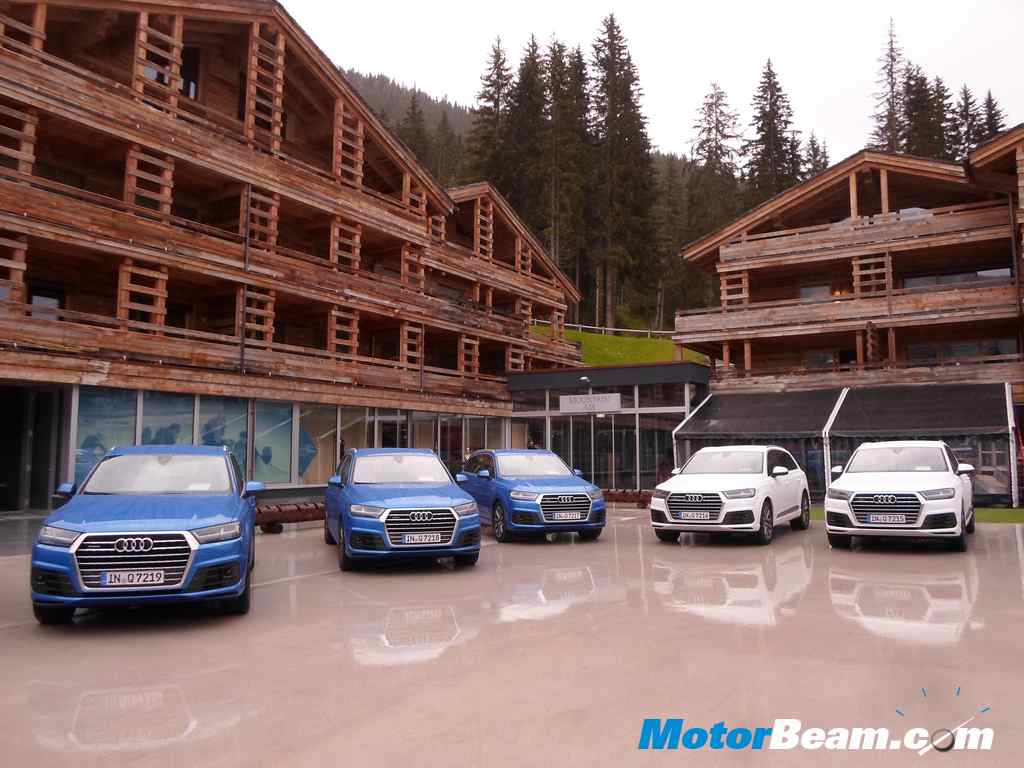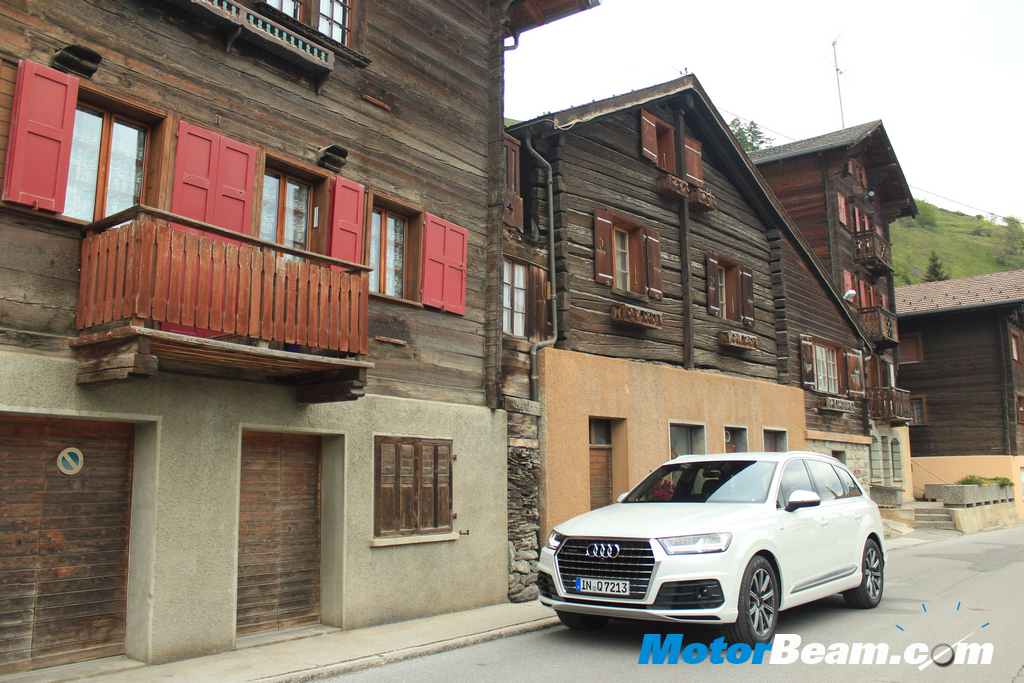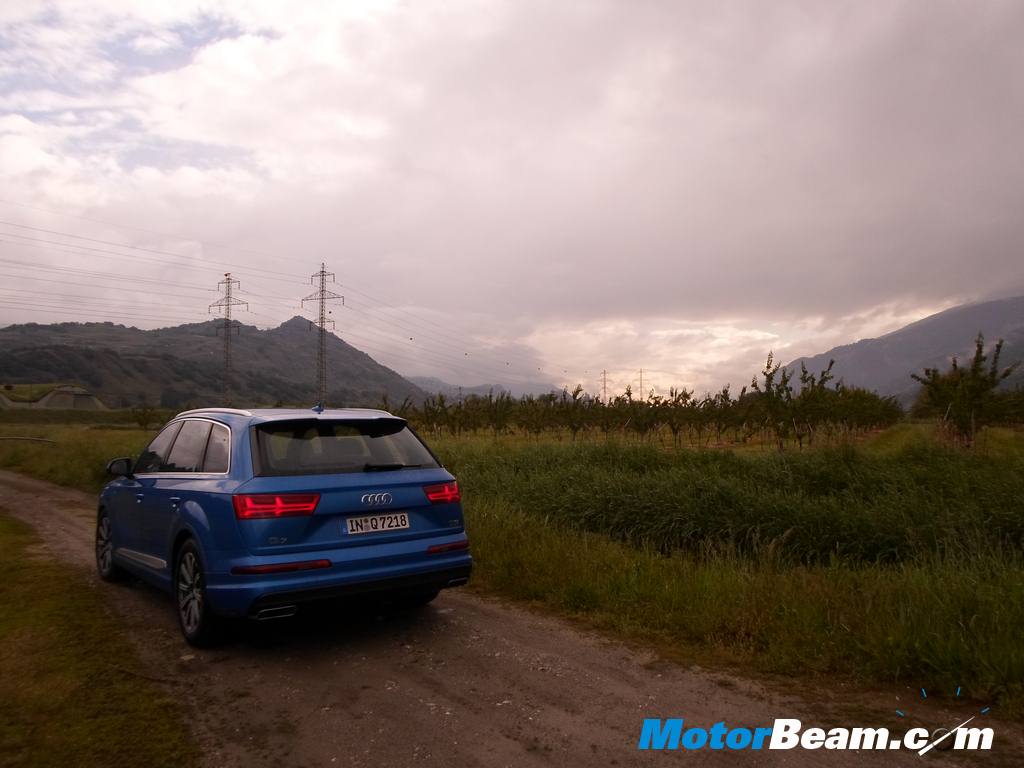
Audi Q7 Review
Car Tested: 2016 Audi Q7
Price OTR Mumbai: Rs. 1 crore (est)
The 2016 Audi Q7 is loaded with technology, the second gen model feels nimble to drive
The premium SUV segment is currently a booming space in the Indian car market, where most of the premium car buyers want luxury with practicality and presence. With the first generation Q7 launched in 2006, Audi was the first luxury brand in India to come up with a full-size 7-seater SUV. The German carmaker has a strong customer base of the Q7 in India. Here are the first impressions of the second generation Q7 that we tested in the iconic mountain region of Verbier, Switzerland.

While the first gen Q7 was also designed from ground-up on a platform (PL71) shared with Porsche Cayenne and Volkswagen Touareg, the SUV has had a secured career till now. Now, Audi thinks it is the right time to take it to the next level. As a result, Audi has endowed the finest and applied the most updated technologies it could lay its hands on to build this incoming SUV on its new MLB-platform using aluminium intensive architecture. By migrating to the newer platform, Audi engineers have been able to knock off around 235 kg of weight, increased the wheelbase and shortened its overall length. The result is that the car gets its wheels pushed to the corners more than its predecessor and also helping in the new profile is the narrowed track. With a kerb weight of just 1995 kg (3.0 TDI), the new Audi Q7 is the lightest in its class. With its lightweight, multi-material body and an all-new chassis, it is comfortable while at the same time offering the typical performance of a sporty Audi and that with top-notch CO2 values. Audi engineers have reduced the fuel consumption of the Q7 by as much as 28 percent in the TFSI and 23 per cent in the TDI.

The car’s profile is similar but sheetmetal treatment is more angular with soft crease lines up front on the mudguard and rear D-pillars. The new vertical grille and new cluster headlamps come with LED DRLs. The rear-end treatment is quite different than before and seems to be inspired by modern MPVs more than SUVs. The interior is designed as a three-row vehicle with seating for seven. The second row is electrically operated and folds flat to create the extra cargo. For the first time, six child seats can be fixed in the car. The car’s interior has been redesigned to optimise space and the exercise begins with the sleek dashboard with full digital display, a pop-up tab which serves as the multimedia infotainment display, thinned out doors (pads to help create more space) and a nice use of stitched leather and combination of very high quality trim materials. Touch points exhibit premium luxury quality.
At launch, two new V6 engines will be offered with all-wheel drive. The 3.0-litre TDI with 272 BHP and the 3.0-litre TFSI with 333 BHP accelerate the new Audi Q7 from 0 to 100 km/h in 6.1 secs (TFSI) and 6.3 secs (TDI), respectively. The diesel V6 consumes on an average just 17.54 km/l, corresponding to 149 grams of CO2 per kilometre. The engines set top marks in the segment of large SUVs. Transmission is 8-speed automatic with Tiptronic. In terms of packaging, new driver aids and safety kit are among the key highlights. The car features second-generation modular infotainment platform along with virtual cockpit.
The new MMI all‑in‑touch control unit comes with large touchpad at the base of the centre console. Other innovations include the expanded services from Audi connect, the Audi tablet for the rear seat passengers and the two sound systems with 3D audio (Bose and Bang & Olufsen depending on trim). Smartphone integration with Google Android Auto and Apple CarPlay is also new. Audi says the new Q7 is one of the first cars worldwide to offer these functions. Audi completely reengineered the suspension, changing front and rear components from double wishbone to a multilink architecture.
The all new Audi Q7 is rich on refinement and NVH having minimal noise
Most of the drive was done in the Alps region of Verbier beginning from the hanger at Sion airport right up to the world famous Verbier ski resort situated at a height of 1531 m above sea level. This big SUV has a cd value of just 0.32 and the first thing noted is that it has extremely well managed NVH levels. On the move, this car almost eerily quiet even at highway speeds with very little wind noise. The TFSI engine is quite powerful in torque delivery and along with the automatic gearbox, work seamlessly in tandem and we didn’t note any turbolag either. As part of the driving dynamics package, several menu driven options are available and when the Sport or Individual mode is selected, the engine mapping, gear holding pattern and steering weight change. Most of the driving was done on motorways and winding mountain roads in and around Verbier. The car feels confident with it brilliant chassis set-up. Despite its size, there’s no tendency of wallowing and the mass of the car isn’t felt. It also feels faster than the quoted figures. The gear selector, when pushed forward all the way, no longer selects park but reverse. The “park” button is integrated in the joystick like in a BMW and unless mastered, will frustrate many new owners so one has to get used to this system pretty fast.
In normal driving conditions, the torque split is tail-happy 40:60, but if conditions demand, the front end can take up to 70 percent of torque while the rear can cope with up to 85 percent. The centre differential is supported by ABS and stability control, which keeps the car in line by ever so slightly decelerating the wheels closest to the apex. The turn radius of this car has been reduced, thanks to the rear wheels also aiding the steering effort. Meanwhile, the lower centre of gravity and redesigned suspension ensures that it feels positively transformed and livelier. It is both comfortable and agile. The coolest feature that we experienced during the drive was the application of semi-autonomous systems, especially the predictive efficiency assistant. In this set-up, adaptive cruise control works with Google Maps and traffic-sign recognition technology to avoid unnecessary acceleration and braking manoeuvres. The diesel variant is also a delight to drive with extremely impressive acceleration qualities. Compared to the petrol TSFI, there’s a minor turbolag, noticeable only in sharp uphills or very fast corners.
The new Audi Q7 is much more luxurious and competent. The wagon-like design will take time to sink in but there are some interesting styling cues that make it look quite attractive. At the same time Audi will also be looking at a new price point as Ingolstadt thinks that it does merit that increment. The all-new Audi Q7 looks quite promising and represents a great leap in the way Audi has evolved the SUV for its second innings.
What’s Cool
* New lightweight platform makes it a breeze to drive with better fuel efficiency and responsive engines
* Top quality interiors with latest tech including new MMI system, Apple CarPlay and Android Auto
* High on safety and gets semi-autonomous systems such as adaptive cruise control
What’s Not So Cool
* The new styling will grow on you over time
* It will be significantly expensive than the outgoing Q7




